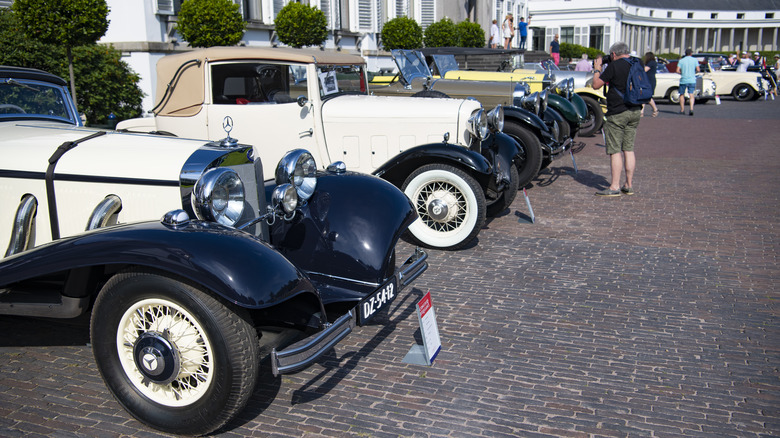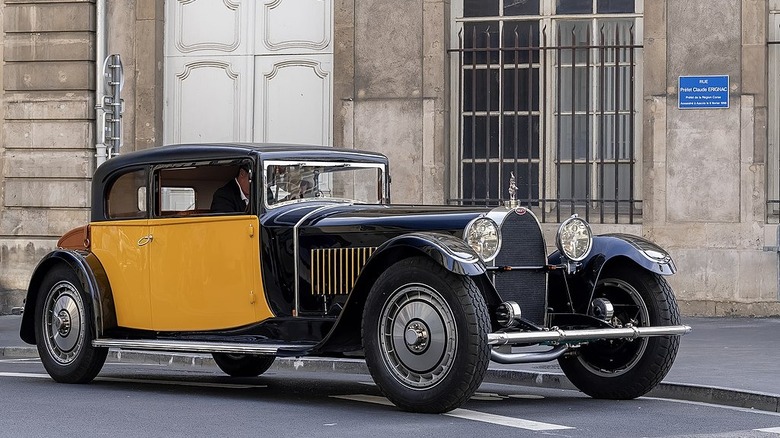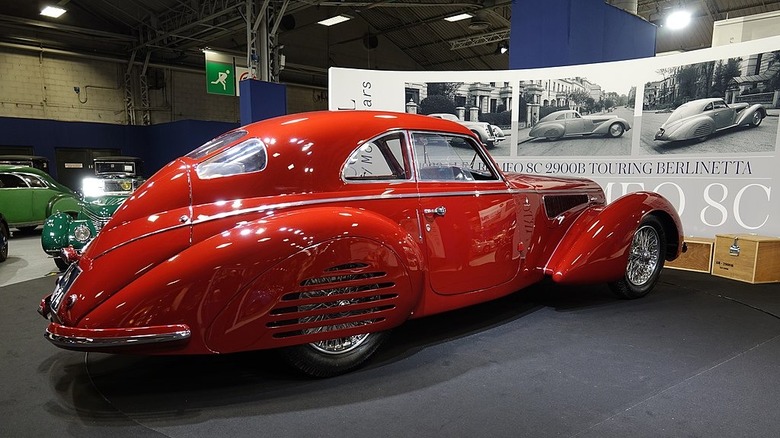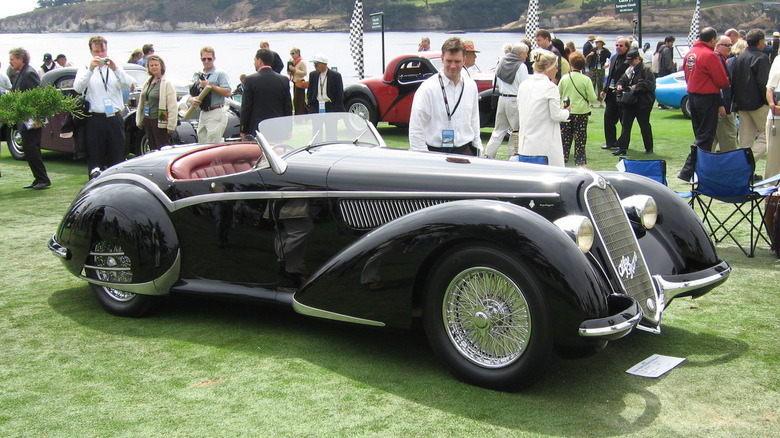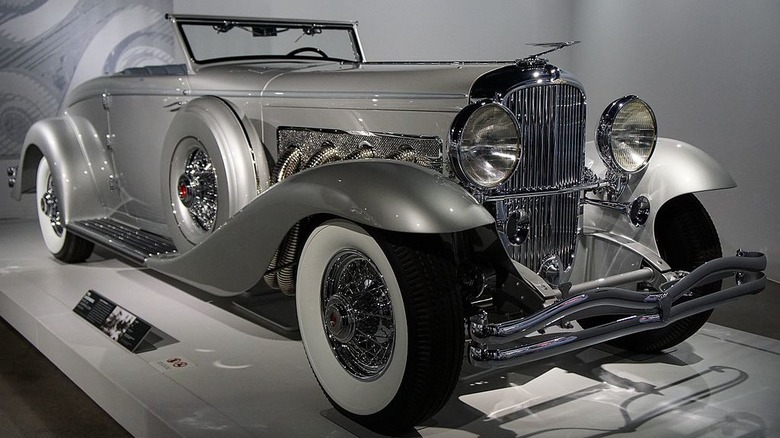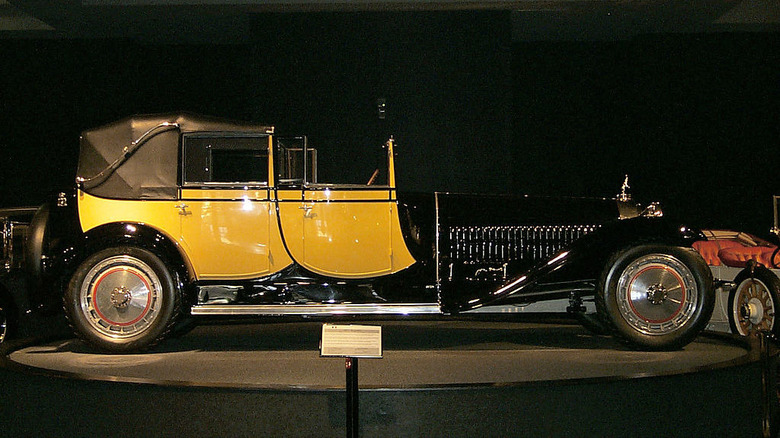5 Of The Most Expensive Pre-War Cars Ever Sold
As it turns out, the term "pre-war car" can mean different things depending on who you ask. Some refer to "pre-war" as the period up to the start of World War I (September 1914), while others use the golden era of autos leading up to the beginning of World War II (1939 or 1941).
The Ford Model T was first introduced in 1908, six years before the start of the first world war. For several years the car remained a toy for the rich and famous, while the horse remained the primary mode of transportation for the vast majority of those who couldn't afford to buy one.
World War I inspired a zeitgeist within the newly formed automotive industry, and when the war ended in 1918, it led to a creative explosion in how and what cars could be around the globe. Automobiles became widely adopted in the U.S. during the 1920s, with some of the most exquisite examples of no-holds-barred car fabrication occurring in the golden age of the 1930s.
Given that, we will stick with this period before World War II, when automakers really began to spread their wings and unleashed a diverse number of four-wheeled beauties unlike the world had ever seen. Here are five cars, all made during the 1930s (none in the United States), that will set your wallet on fire.
Bugatti Royale Kellner Coupe
In the mid-1920s, Ettore Bugatti planned to sell the best (and biggest) car money could buy. He initially planned to build 25 Type 41 Royales when the average annual income was around $1,388, so literally only royalty could afford the $43,000 price tag. Only seven were built. Bugatti allegedly wrecked one (possibly a prototype), while three others were sold to outside parties.
The Royales were big cars, spanning 21 feet and weighing nearly 7,000 pounds. Under the hood sat a monstrous 4.6-foot long by 3.6-foot high engine. The 12.8-liter 779-cubic inch "Straight 8" was meant for the French Air Ministry to power airplanes. Mated to a 3-speed, the 3.5-ton beast had a top speed of around 100mph. All were individually bodied by different coachbuilders, some multiple times, so they all looked very different.
When the Nazis advanced towards the Bugatti factory in World War II, the three unsold Royales — Kellner car (chassis 41141), Berline de Voyage (chassis 41150), Coupe Napoleon (chassis 41100) — were taken to the Bugatti home in Ermenonville, France, and bricked up behind a wall. The Nazis never found them, and all six still exist.
The Kellner and Berline were sold to an American Le Mans driver in 1950. Each car cost him $571, plus two brand-new General Electric refrigerators, which were impossible to get in France. In 1987, the Kellner car was sold at Christie's for $9.7 million. Three years later (1990), it sold for $15.7 million. In 2001 it was reportedly put up for sale via Bonhams for approximately $10 million, but the specifics of that sale still remain unknown.
The vehicle in the picture above is not the '31 Kellner but a Weymann, which looks very similar in most respects.
[Image by Alexandre Prevot via Wikimedia Commons | Cropped and scaled | CC BY 2.0]
1939 Alfa Romeo 8C 2900B Touring Berlinetta
A mere 10 long (lungo) wheelbase Alfa Romeo 8C 2900B models were built, with just five of those sporting the Carrozzeria Touring Berlinetta bodies.
One is sitting in the Alfa Museum in Italy, three other restored models are in the United States. Two of those won "Best of Show" at the Pebble Beach Concours d'Elegance in Monterey, California. The final one — actually the second one built (chassis 412024) — sold at the Rétromobile auction in France in 2019 for $18.98 million.
The Carrozzeria packed a 2.9-liter 180hp DOHC Straight 8 with dual Roots-type superchargers that could push it to approximately 109 mph. It was mated to a 4-speed manual transmission and had an independent double-wishbone front suspension and a swing axle rear suspension. Transverse semi-elliptical leaf springs and hydraulic friction dampers rounded out the ride.
While most of the early history of this car is unknown due to inadequate paper trails, it's believed to have once been owned by Italian Foreign Minister Galeazzo Ciano, who was the son-in-law of Benito Mussolini.
At the time the car was sold in France, the chassis 412024 Alfa Romeo Carrozzeria had been owned by the same family for the previous 43 years and only had 65,000 km (40389 miles) on the odometer. While the engine was rebuilt sometime in the 1980s and the car changed color several times throughout its life, it was otherwise mostly "unrestored."
[Image by Y.Leclercq via Wikimedia Commons | Cropped and scaled | CC BY-SA 4.0]
1939 Alfa Romeo 8C 2900B Lungo Spider
In 2016, another Alfa Romeo — a 1939 8C 2900B Lungo Spider by Touring — was sold at the Pebble Beach Concours d'Elegance in Monterey, California, for $19.8 million. It's only one of about twelve known to still exist, and one of only seven that sit on the long (Lungo) chassis.
The Spider packed almost identical features as the Touring Berlinetta — a 2.9-liter 180hp DOHC inline eight with dual Roots-type superchargers but could push it just a bit faster at 115 mph. It, too, was mated to a 4-speed manual transmission, had a double-wishbone front suspension, and a swing axle rear suspension. The same transverse leaf springs and hydraulic friction dampers also rounded out this ride.
At 2,756 pounds, the car was extremely light. It achieved this by borrowing a technique from a French airplane racer and inventor named Charles Weymann. This Superleggera method was used to build the inner framework with thin, hollow steel tubes wrapped in aluminum panels and fabric stuffed in between them. It kept the weight down and allowed the designers to contour the body as they pleased, thus making the Spider incredibly aerodynamic.
The vehicle in the picture above is not the '39 Touring Spider but a very similar 1937 model. The '39 sold has fully enclosed rear wheel spats and a black leather interior. The chrome trim is also a bit more subtle on the '39.
[Image by Simon Davison via Wikimedia Commons | Cropped and scaled | CC BY 2.0]
1935 Duesenberg SSJ
When you're talking rare, the SSJ model Duesenberg might be the rarest of them all, as only two were built – as a publicity stunt. Interestingly, while many enthusiasts call this model an SSJ, it was never officially referred to as that by Duesenberg.
In a tale ideally suited for Hollywood, Duesenberg sold one to legendary actor Gary Cooper to bolster its image to the Tinsletown elite. A different version of the story claims another legendary actor, Clark Gable ("Gone With the Wind"), got the first one. Cooper saw it and ordered an even faster one. Whatever the case, only two exist (engines labeled J-563 and J-567 respectively).
Both were slapped with roadster bodies designed by Herb Newport and built by La Grande. And while Duesenberg J models could be purchased with 142.5 inches or 153.5 inches wheelbases, factory fresh SJ's (remember, they weren't called SSJs by the company) came with a 125-inch wheelbase.
Loaded with a 448-cubic inch, 7.3-liter, DOHC, 32-valve, centrifugally supercharged, Straight 8 with twin Schebler carburetors, it reportedly produced 400 horsepower. The top speed was said to be 140 mph, but it was clocked (electronically) at Muroc Dry Lake in California only doing 126.6 mph. Still, it reached 60 mph in less than eight seconds, making it faster than some Ferraris from the late 70s.
The J-563 engine Duesenberg was put up for sale by Gooding & Co. at Pebble Beach in 2018 and sold for $22 million.
The automobile in the picture above is not the Duesenberg sold, but a similar 1933 SJ model. The '35 sold doesn't have the spare tire and has a slightly different paint scheme.
[Image by Steve Ginn via Wikimedia Commons | Cropped and scaled | CC 1.0]
Bugatti Royale Berline de Voyage
You are not mistaken if this car sounds similar because it's one of the three previously mentioned Royales that Bugatti hid behind a wall at his home during WWII.
If you recall, the Berline de Voyage and the Kellner car were sold to Briggs Cunningham in 1950 for a pittance. The following year, Cunningham sold the Voyage to Cameron Peck. It wound up in the Bill Harrah Collection in Reno, Nevada, sometime later. In 1986 it sold for $6.5 million to a Texas real estate developer, who later sold it to Domino's Pizza magnate Tom Monaghan for $8.1 million.
In 1999, Don Williams and Richie Clyne got their hands on the Voyage and put it in their collection at the Imperial Palace Hotel and Casino in Las Vegas. It eventually became part of Williams' renowned Blackhawk Collection in Danville, California.
Finally, in 2021, The Blackhawk sold the Type 41 Royale Berline de Voyage (chassis 41150) to an anonymous European buyer for an undisclosed amount. Famed car auctioneer Rick Cole says he assisted with its sale (corroborated by Don Williams at The Blackhawk), asserting it sold for more than the $22 million paid for the '35 Duesenberg SSJ, thus making it the most expensive pre-war car ever sold.
[Image by Craig Howell via Wikimedia Commons | Cropped and scaled | CC BY 2.0]
